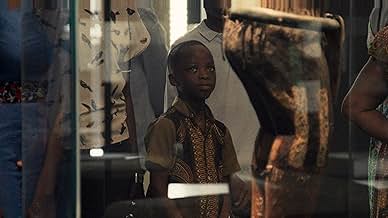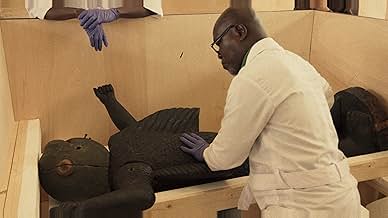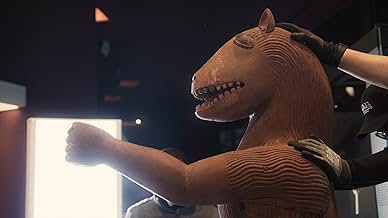Dahomey
- 2024
- 1 घं 8 मि
अपनी भाषा में प्लॉट जोड़ेंThe journey of 26 plundered royal treasures from the Kingdom of Dahomey exhibited in Paris, now being returned to Benin. Diop artistically voices a new generation's demands.The journey of 26 plundered royal treasures from the Kingdom of Dahomey exhibited in Paris, now being returned to Benin. Diop artistically voices a new generation's demands.The journey of 26 plundered royal treasures from the Kingdom of Dahomey exhibited in Paris, now being returned to Benin. Diop artistically voices a new generation's demands.
- निर्देशक
- लेखक
- स्टार
- पुरस्कार
- 13 जीत और कुल 51 नामांकन
फ़ीचर्ड समीक्षाएं
Dahomey raises important questions about cultural assimilation and the wounds of colonialism that remain open in many cultures exploited by European powers that shield themselves from responsibility in a society that does not care much about the impact of the exploitation of first world countries on the rest of the world.
Despite the short duration, the dense theme makes the experience a little longer than it seems, but this discomfort is necessary.
The film captures very well how artifacts from our culture tell our story.
As a viewer from Europe, I felt a slight lack of explanation about what modern Benin is like beyond its capital, which would have helped form an opinion on the discussions presented by the Beninese in the film. However, it's clear that the filmmaker did not set out to provide a comprehensive overview of the country's current state.
The narrative use of "26," the artifact that serves as the story's guide, is one of Diop's masterstrokes. Giving a statue its own voice-imbued with a subjective and almost spiritual perspective-turns the narrative into something profoundly human and, paradoxically, otherworldly. The statue's low, wise voice leads us through its journey of displacement, capture, and eventual reconnection. When we see the world through "26's" eyes-like in the scene where light fades as it's packed into a box-we feel the symbolic weight of being stripped of one's roots and confined to a foreign space.
Diop's cinematography is another standout feature. She skillfully balances the grandeur of Benin's landscapes with intimate shots of hands touching, holding, and carrying the artifacts. Every movement captures not just the object itself but the emotional and spiritual bond between the people of Benin and their cultural heritage. This visual duality creates a rhythm that feels almost meditative, giving the audience time to reflect on the depth of loss these artifacts represent-and the powerful act of their return.
Yet "Dahomey" doesn't stop at celebrating restitution as a triumphant event. The film honestly and thoughtfully explores the conversations sparked within the community as the artifacts are brought back. The joy of their return is intertwined with deeper questions: What exactly was lost? Can the void left by centuries of cultural colonialism ever be filled? While some voices express optimism about reclaiming these objects, others question the impact on a history that has been fractured and reshaped by foreign hands. Diop wisely observes these discussions without passing judgment, allowing the viewer to absorb the layers of meaning embedded in every exchange.
At just 68 minutes, the film might leave some viewers feeling like there's more to uncover. The conversations are so rich that a deeper dive would have been welcome. Still, this brevity is part of "Dahomey's" impact: it leaves you wanting to continue the dialogue, both internally and with others. The film doesn't offer easy answers or definitive solutions. Instead, it invites ongoing reflection on the intersection of history, identity, and justice.
"Dahomey" is a brilliant example of how cinema can serve as a tool for resistance and reconstruction. Diop doesn't just document a historic moment-she transforms it into a sensory and intellectual experience that reverberates far beyond the screen. The pain of colonialism is palpable, but so is the hope for a more just future, where stolen stories can be reclaimed and retold by those to whom they truly belong. This is a film that demands attention, reflection, and, above all, action. A work of art that reminds us the fight for historical justice is both a collective and deeply personal act.
Listening to Beninese talk about the significance of gaining these pieces back and all of the relics still in France was the meatiest part of this film and the most engaging for me. Often, I feel that a unsubstantial film could be edited for improvement. In this case, I feel that a lot of substance could have been added.
क्या आपको पता है
- ट्रिवियाOfficial submission of Senegal for the 'Best International Feature Film' category of the 97th Academy Awards in 2025.
- भाव
[first lines]
Voice of Artifact #26: As far back as I can go, there has never been a night so deep and opaque. Here, it is the only possible reality. The beginning and the end. I journeyed so long in my mind but it was so dark in this foreign place that I lost myself in my dreams, becoming one with these walls. Cut off from the land of my birth as if I were dead. There are thousands of us in this night. We all bear the same scars. Uprooted. Ripped out. The spoils of massive plundering. Today, it's me they have chosen like their finest and most legitimate victim! They have named me 26. Not 24. Not 25. Not 30. Just 26.
टॉप पसंद
विवरण
बॉक्स ऑफ़िस
- US और कनाडा में सकल
- $1,00,959
- US और कनाडा में पहले सप्ताह में कुल कमाई
- $25,960
- 27 अक्टू॰ 2024
- दुनिया भर में सकल
- $5,93,052
- चलने की अवधि1 घंटा 8 मिनट
- रंग
- ध्वनि मिश्रण
- पक्ष अनुपात
- 1.78 : 1
इस पेज में योगदान दें




















